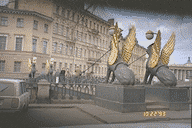
The pill worked. Hooray for modern medicine. I woke up around 7:45. When I got out of the shower (which must have a leak, as I was careful and still there was a pool of water on the floor) breakfast was ready. Like magic, Olga is.
The weather was clear but cold. Two sweaters and a jacket like I wish I'd worn yesterday. We began with a visit to the Revolutionary Museum, situated in the home of a ballerina and lover of the last Tsar. Olga paid the Russian-citizen admission price for both of us and I entered with my mouth shut. Olga whispered to me in English as we passed the exhibits, though we skipped the ones near the women who were seated watching us from various points in the museum. The museum is somewhat similar to the Lenin Museum in Moscow, with more emphasis on the socialist movement as a whole and on the various competing politicla forces at work in 1917 Russia. All in all I would judge the Lenin Museum more interesting.
Downstairs, there was a wax museum, depicting various people who were the perpetrators or victims of revolutionary violence. The exhibit's theme was that violent revolutions don't work. The guide carefully avoided mentioning that Lenin and his cohorts were some of the worst offenders, leaving the unsuspecting audience with the implication that Lenin was a good apple in a bad crate. (Lenin was featured, but only as the victim of an assassination attempt.)
After the museum, we walked to Nevsky Prospect and went down a side street in search of the bridge I'd seen on TV, specifically the "Petrograd, July 1917" episode of The Young Indiana Jones Chronicles, since we hadn't been able to find it the day before. This time we found it, just down the street from Kazansky Cathedral. (It's pictured above.)
We ate lunch at a busy cafe, blini and soup and a sort of bagel-dog and some cabbage salad. There was a small kitten wandering around the place. I was amazed it didn't get stepped on with all the people moving around. In any case, so far I'd have to agree with the consensus that restaurants here are nothing to write home about.
The final museum of the day, and of my stay in St. Petersburg, was the Ethnographical Museum of the Peoples of the USSR, with displays about the native cultures of Siberia, the Urals, and so forth. All standard fare, interesting enough but not unusual. The unexpected find was a gallery full of abstract art on metal by an artist calling himself "Master A." Dynamic, colorful stuff. I commented to Olga that this was the sort of thing I'd be tempted to buy if it were for sale. To my chagrin, she walked over to the woman seated by the door and asked whether the pieces were available. The woman said we'd have to talk to the artist, who had just gone home five minutes earlier. Which was just as well, since I suspected I couldn't afford such artwork if it _were_ for sale.
We sat in the gallery and rested our feet. Suddenly, in came the door woman with a balding brown-haired man in tow. She introduced him as the artist. Olga told him who I was and that I wanted to know how much the artwork cost. His eyes lit up, and he said I should tell him what I thought my favorite one was worth. We walked over to a work I liked. He launched into a long discourse about his work. He wasn't an artist, he said; he was a philosopher, a healer, whose talent was removing his personality completely from his art and letting his contact with God determine what the picture should look like. The result, he said, was a set of images of things beyond man's comprehension, images which our minds would try to make sense of by drawing parallels with familiar objects or sights. He asked me what I liked about the picture I'd selected. Half serious, half playing along with him, I answered that it seemed almost alive. That set him off on another diatribe about his special gifts. Finally, he asked what I'd pay. It took me several seconds to answer. At home, such things would sell for upward of a thousand dollars, but of course I didn't want to say that. I started to stall by saying I didn't really shop for art much, so I wasn't sure exactly. Just then, a famous sculptor, creator of several of the monuments around town, walked in and distracted Master A. He quickly excused himself, saying it was an honor that someone who didn't buy art would consider his work. We left while we had the chance and continued walking around the museum.
When we were done there, we still had an hour to kill before the start of our musical event, so we had coffee and cakes at a restaurant in the back of an ice cream shop. The speakers blared such contemporary hits as "Stayin' Alive" and "Fame." It's nice to know that the 70s are alive and well somewhere.
After the concert (another organ recital, this one with a much more interesting set of pieces) we metroed to the station nearest the apartment. This time Olga flagged down a car after about a minute of waiting for a tram. The way home was thus considerably warmer, and shorter, than on previous nights.
The next morning we would leave for Novgorod. I set my alarm for 5:30 per Olga's instructions, packed, and went to bed early, with another sleeping pill for good measure.
Continue, go back, or go to the index